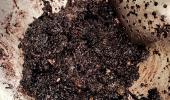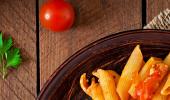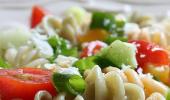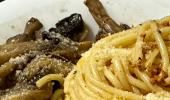
When you are cooking for two -- after having always cooked for a family of four or five -- it's often difficult to get portion sizes right.
That's partly because halving recipes is a little problematic, especially when minimum quantities of what one buys in a store is nothing less than 250 gm, be it vegetables off an app grocer, yoghurt, meat/fish etc.
That's why I put so much store in freezing. Freezing is the simplest solution to dealing with excess food that can come in immensely handy later, when your work schedule is not permitting you to cook on one or another busy weekday night.
I cannot stress enough how fresh the freezer keeps food. For many there is a stigma about frozen food that refuses to go away and it is equated with old food. Most assume that food kept in the fridge for a day or two, or 5, is fresher than what you stored in the freezer the day you cooked it.
How wrong they are! If you stick food into a freezer (that maintains good temperatures) shortly after you cook it, it is going to remain super fresh. And much fresher than something that has gone a bit stale after a day in the fridge. It is after all frozen in time and maintains the freshness of the moment/date stamp when it was put into the freezer.

Over the years, with some amount of experimenting, I have learnt exactly what freezes well and what does not. And when I say freeze well, I am not referring to freshness. Anything placed in the freezer stays really fresh, but what it can lose is its texture -- ie become crumbly or too dry.
And I must emphasise over and over again how convenient it is to have a few cooked things at hand, when you need them, so you don't have to reach for your phone, and the Swiggy app, and order in outside food that is oily, over-masala-ed and not as hygienic or taaza as home food, even freezer food.
Also keeping the ingredients used for cooking a dish, pre-prepped, in the freezer, is extremely helpful and time-saving, like pre-boiled, unseasoned dal, freshly-ground tomato puree, masalas and powders. Since I am cooking just for two, dals, maida, rice flour, spices that you often have to purchase in minimum 500 gm quantities get weevils or become rancid outside. So those too I bung into the freezer or fridge to extend their life. Masalas, especially, stay in the freezer as pungent as they were on the day you made them.

But remember to store anything bound for the deep freeze in air-tight containers or ziploc bags. As result my freezers are jam packed as you can see in the pic above!
On a regular weekly basis, I cook a mixture of soups, salads, pastas, sandwiches, dal, sambar, pulaus, tadkaris in both north Indian and South Indian style.
My husband is non-vegetarian and cooks his own dishes one or two times a week, mostly seafood. So, my list of what stays well in the freezer reflects the mixed cuisines we eat. And a lot of Indian food, I have discovered, freezes excellently.
Here's my list of what does well in the freezer, divided into types of food and components of cooking
Ingredients used in Indian cooking:
Grated coconut. Paneer. Boiled kabuli channa or chickpeas. Boiled rajma or red kidney beans and varieties of vaal or double beans. Dry masalas like sambar powder, garam masala, goda masala, rasam powder, dhania powder. Chopped raw suran. Chopped kadu or pumpkin. Chopped bhindi or okra. Chopped garlic. Green chutney. Coconut chutney. Coconut milk. Store-bought, sealed yoghurt for a brief amount of time (a week).
Ingredients used in Western cooking:
Grated cheese, either generic types available from certain brands, or specific types of cheese like cheddar, mozzarella. Blocks of Parmesan cheese. Blocks of feta cheese. Blocks of cheddar. Blocks of mozzarella. Burrata (taste remains authentic; loses a bit of elasticity). Parboiled corn, peas, carrots or broccoli. Steamed spinach and other greens. Pre-fried chopped mushrooms. Passata or tomato puree. Butter. Bread. Dried herbs. White sauce (bechamel). Pizza bases.
Ready Indian dishes:
Sambar. Dal. Imli chutney for imli rice. Among cooked sabzis, anything raseela (ie with gravy) does very well, be it kuttus, kurmas, kuzhambus, Channa Masala, Alu Curry, Olan. Among dry fry or pan-fried, lightly-seasoned, simple tadka-ed vegetables, poriyals and theeyals -- potatoes, spinach, tindli, cauliflower (not cabbage), beans. Pulaus that have been cooked in a little oil or ghee. Pongal. Khichdi. Part or half-fried samosas, kachoris.
Ready Western or non-Indian dishes:
Soups. Sauces. Hummus. Muhammara. Sourdough bread. Part-fried spring rolls. Frozen French fries (readily available; store in your freezer). Pizza bases. Pizza sauce.
As per my husband, ready non-vegetarian items:
Raw fish and prawns already marinated. Meat marinated in advance for dry fries, curries, barbecuing (advance marination makes the meat taste better). Fish curries. Pork curries. Kheema. Meat and chicken curries. Sausages. Ham. Salami. Part-fried kebabs.
Other stuff:
Boiled milk. Unboiled milk in plastic packets. Mango juice ie aamras. Pre-cut strawberries. Sliced pineapples.
The other day my younger daughter and I made buttery ravioli with a stuffing of beetroot, red cabbage and potatoes, finished with a little cheese. I was left with an extra quantity of pasta dough which I patted into a disc, put in a ziploc bag, froze, and created into tagliatelle or wide noodles, five days later. Both recipes are below.
I am an eager subscriber of YouTube's Pasta Grannies programme and the ravioli was my version of 88-year-old Chiara's Milanese/Cortina d'Ampezzo-style ravioli. She used just beets. I was worried it would be too sweet and elected to add -- like you would for a Polish pierogi dumpling -- grated red cabbage and mashed potatoes too.
I chose organic beetroot, which I found on Instamart, which turned out less sweet, like I was looking for (generally beets picked earlier are less sweet). Her stuffing used some exotic Italian cheeses. I made do with Amul, paneer and cream cheese and added some grated Parmesan while serving.

Ravioli Stuffed With Beets, Red Cabbage, Potatoes
Serves: 4
Ingredients
- 10 pods garlic, finely chopped
- 1½ tbsp butter
- 4 tbsp chopped greens of the spring onions
- 2 tbsp chopped fresh parsley
- 4 tbsp grated Parmesan cheese
- Salt to add to the water while boiling the ravioli
For the ravioli dough:
- ½ kg maida or all-purpose flour + a little extra for rolling the ravioli
- ½ tsp salt
- 4 eggs
- 1 tbsp extra virgin olive oil
- Water
For the ravioli filling:
- 1 organic beetroot, boiled, peeled, grated
- 1 large potato, boiled, peeled, mashed
- ½ cup grated red (purple) cabbage
- 1 tsp jaiphal or nutmeg powder
- 1 tsp freshly-ground black pepper powder
- 1½ tsp salt
- 5 tbsp Amul's grated mixed cheddar and mozzarella
- 100 gm paneer, grated (I prefer the softer ID paneer)
- 2 tbsp cream cheese

Method
For the ravioli stuffing:
- In a bowl, mix together all the ingredients for the stuffing and mash it up.
- Keep aside.
For the ravioli dough:
- Knead the maida, eggs, salt into a stiff dough with a little water -- gradually add the water, as little as possible, because the dough should be dry and hard not soft.
Make into a ball, grease with the olive oil.
Keep aside, covered, for 2 hours.
 =
=
Assembly
- Roll out 1/3 of the dough as thin as you can get it, on a ledge or flat surface, powdered with a little extra maida (keep the rest 2/3 dough for the next two rounds of rolling out).
Cut into thin long strips (please see pics above).
Place about 1 tsp or less of the beetroot-potato-red cabbage-cheese stuffing on the start of the strip and then the next tsp about an inch apart and continue adding as you go down the strip.
Place another strip of rolled-out dough on top and seal the side edges and cut into 1''x 1'' ravioli pockets and seal the top edges tightly, preferably with indentions of a fork.
Repeat for all. - Roll out the next lot of dough and create the next batch of ravioli pockets -- you will get about 25 ravioli pockets in all.
- Reserve the leftover 1/3 dough.
- In a large saucepan, boil water over high heat and add a dash of salt.
Add in about 8-10 ravioli pockets at a time.
They will sink to the bottom.
After they boil and rise to the top and bob on top for a few minutes drain with a slotted spoon or jharia into a covered bowl.
Repeat for the balance pockets. - In a large frying pan heat the butter and garlic over medium heat, for 5 minutes till the garlic is cooked and the butter browns slightly and add the cooked ravioli and chopped green onions to it.
Toss lightly till all the pieces of ravioli are coated in butter and the onions.
Take off heat and plate, about 5-8 ravioli pockets per person (they are filling) and serve hot, garnished with cheese.
Zelda's Note: Flatten the leftover 1/3 portion of pasta dough into a disc and store in a Ziploc bag in the freezer to make into tagliatelle later.
Tagliatelle or Flat Noodles
Serves: 1
Ingredients
- Leftover pasta dough
- 1 tsp butter
- 5-6 tbsp sliced burrata cheese
- 1 tbsp chopped greens of spring onions
- Pinch salt + extra for salting the pasta water

Method
- Bring the dough to room temperature.
- On a ledge or flat surface, powdered with a little extra maida, using a large rolling pin, roll the dough out into a large circle or square, about 1 mm thick.
Roll the circle or square into a long roll and slice to make tagliatelle. - Bring a large saucepan of water to boil.
Add salt.
Then add the tagliatelle.
Boil 8 minutes and drain - Butter and garnish with the cheese and green onions and serve hot.











